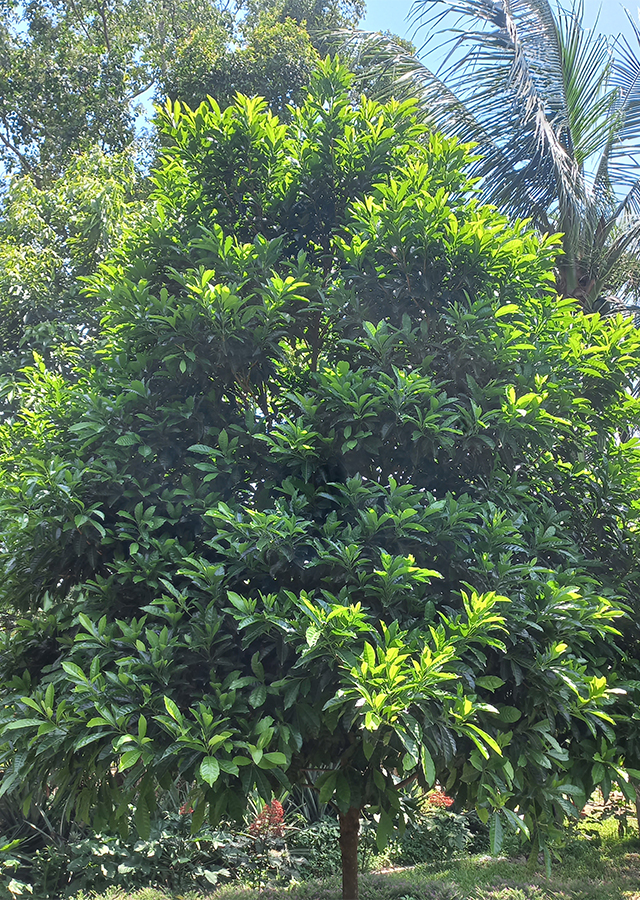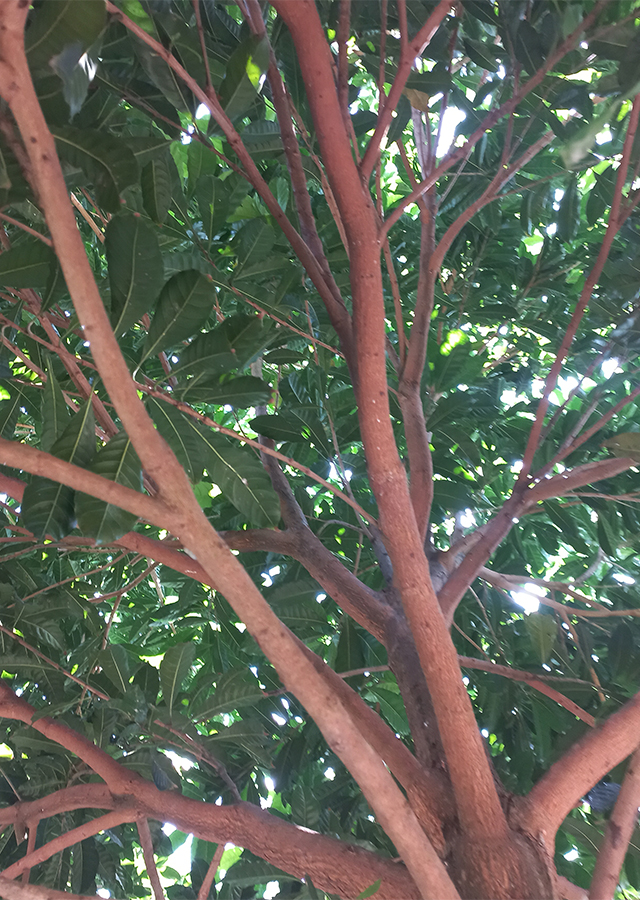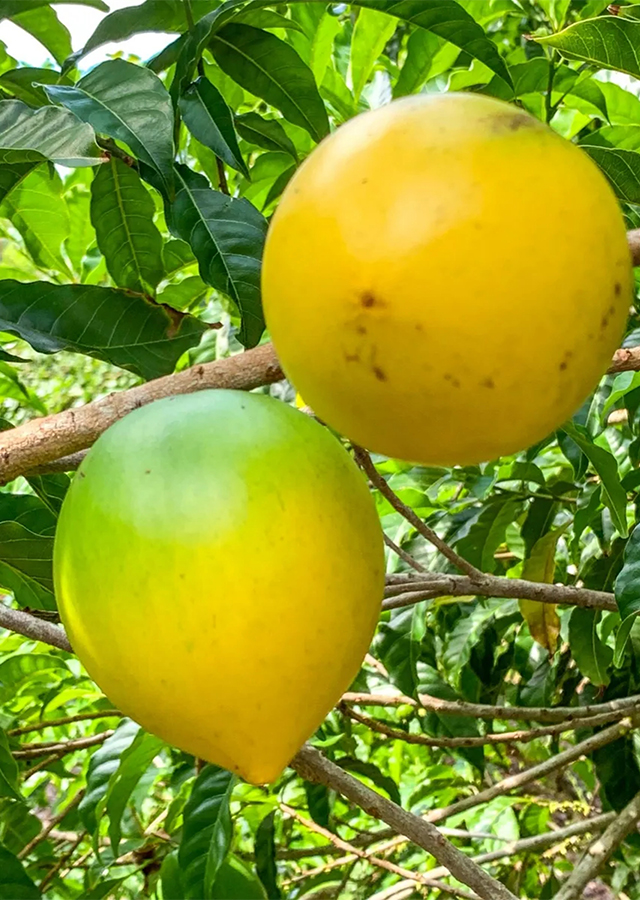Abiu
Pouteria caimito (Ruiz & Pav.) Radlk.
Sapotaceae
Location in our garden
Orchard



Synonym
Achras caimito Ruiz & Pav.
Guapeba caimito (Ruiz & Pav.) Pierre
Labatia lasiocarpa Mart.
Habitus
Trees. An evergreen perennial tree with a dense crown that grows about 3-15 m high but may reach 35 m in favorable situations
Part Used
Leaves
Fruit
Latex
Growing Requirements
Full Sunshine
Habitat
Forest
Coastal
Overview
Pouteria caimito is a tropical fruit that is native to Trinidad, Central and South Tropical America. It is wildly grown in lower eastern part of Andes from Southwestern Venezuela, Para, Guyana and Brazil to Columbia, Peru and Ecuador. It was cultivated by Amerindians which was widely spread in Amazon. It is also found in Colombia areas such as Meta, caqueta and Vaupes, abundantly in Venezuela, Amazonas. It is used as animal food and a medicine and for food. Abiu fruit contains essential minerals and vitamins such as riboflavin, thiamin, Vitamin C, niacin, iron and calcium. The wood is heavy, hard, straight-grained, of medium texture. It is moderately resistant to insect attack, and moderately durable. It is used for construction and external work.
Vernacular Names
Caimito (Spanish), Abieiro (Portuguese), Abi (Brazil), Lucuma (Peru), Temare (Venezuela), Abiu (German, Japanese, Philippines), Caimito Amarilla (Columbia).
Agroecology
Abiu can be found in forests, especially in areas that are seasonally flooded, and by the coast, at elevations from sea level to 1,500 m. A tree of the hot, wet, tropical lowlands, it requires a year-round moist and warm climate. Plants are intolerant of frost. Succeeds in full sun and in dappled shade. Grows well in wet soils. Prefers an acid soil.
Morphology
- Stem - straight bole 30-50 cm in diameter, a gummy latex, white or reddish, exudes from wounds in the bark.
- Leaves - alternate, oblong to elliptic, 10-20 cm long and 3-6 cm wide, short-pointed at the apex, sometimes long-tapering at the base; smooth or with a few scattered hairs.
- Flower - small, cream or off-white hermaphroditic flowers are borne either individually or in small clusters of two to five flowers. They are borne on the leaf axils on long, thin pedicels and have either four or five petals, 4-8 mm long . They open in the morning and last about two days.
- Fruit - berry, ovoid, elliptical or round, 4-10 cm long, sometimebezenoid
- s having a short nipple at the apex; with smooth, tough, pale-yellow skin when ripe and fragrant, white, mucilaginous, translucent, mild-flavored, sweet or insipid pulp, downy when young, containing 1 to 4 seeds. Until fully ripe, the fruit is permeated with latex and is very gummy and astringent.
- Seed - brown, with a pale hilum on one side
Cultivation
- Generative propagation is by seed. Once extracted from the fruit, seeds do not remain viable for more than a couple of days and should therefore be planted as soon as possible into clean, well-drained media. Sow in a nursery seedbed in semi-shade. They will germinate in 15 to 20 days. When the seedlings are 10 cm high, the 2 weakest are removed. The strong one is set out when 30-40 cm high. Spacing is 6 x 5 m.
- Vegetative propagation is by grafting - grafted or budded onto seedling rootstocks and begin fruiting in 1 to 2 years.
Chemical Constituents
Palmitic acid, α-copaene, hexadecy acetate, taraxerol, ß-sitosterol, lupeol, a-amyrin, erythrodiol, tetracyclic triterpene Dammaremdiol II, 1-(2-Hidroksietil)-1,2,4-triazole, 5-hydroxymethylfurfural, 1-methyl-5-fluorouracil, trans-geranylgeraniol, squalene, spinasterol, alkaloid, terpenoid, flavonoid, lapachol, phenylpropaoid, proanthocyanidin and benzenoid.
Traditional Medicinal Uses
- In Brazil, fruit used for treating coughs, colds, bronchitis, and various pulmonary disorders.
- Latex used for diarrhea and fever; applied to abscesses. Also used as vermifuge.
- It is used as astringent, anti-inflammatory, anti-anemic, febrifuge, and anti-diarrheal.
Part Used
Reference Sources
- Fern, Ken. (2021). Useful Tropical Plants: Pouteria caimito. https://tropical.theferns.info/viewtropical.php?id=Pouteria+caimito. 21-05-2022.
- Franca, C.V., et al. (2016). Potential radical-scavenging activity of Pouteria caimito leaves extracts. Journal of Applied Pharmaceutical Science Vol. 6 (07): 184-188. DOI: 10.7324/JAPS.2016.60727. Also available: https://japsonline.com/admin/php/uploads/1938_pdf.pdf.
- Healthbenefitstimes. (2021). Health benefits of Abiu Fruit. https://www.healthbenefitstimes.com/abiu-fruit/. 21-05-2022.
- Kew Royal Botanic Gardens. (No date). Plant of the World Online: Pouteria caimito (Ruiz & Pav.) Radlk. https://powo.science.kew.org/taxon/urn:lsid:ipni.org:names:788845-1. 21-05-2022.
- National Park of Singapore. (2022). Flora & Fauna Web: Pouteria caimitohttps://www.nparks.gov.sg/florafaunaweb/flora/3/0/3085. 21-05-2022.
- Stuartxchange. (2020). Philippine Medicinal Plants: Abiu. http://www.stuartxchange.org/Abiu. 21-05-2022.
- Purdue University. (2021). Center for New Crops & Plant Product: Abiu. https://hort.purdue.edu/newcrop/morton/abiu.html. 21-05-2022.


